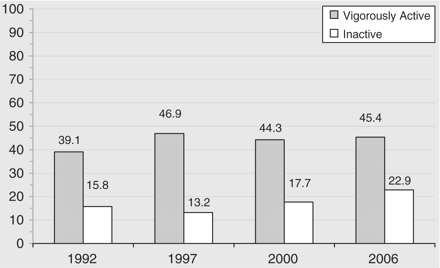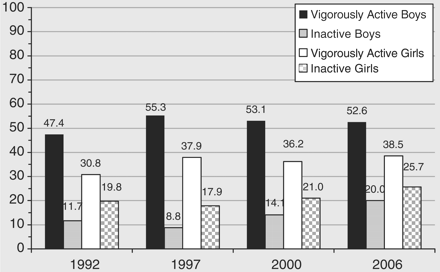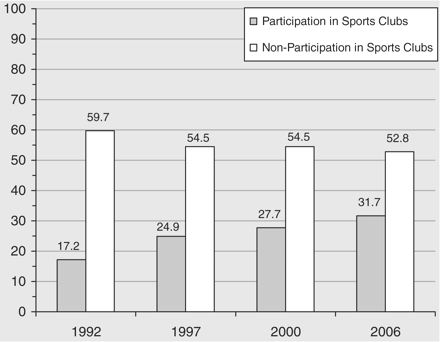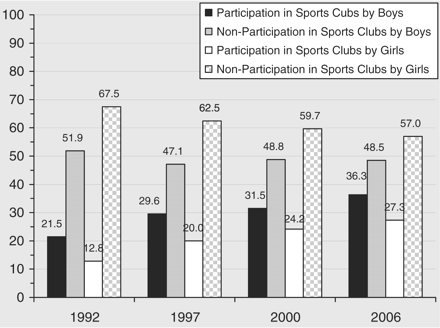-
PDF
- Split View
-
Views
-
Cite
Cite
Sigríður Þ. Eiðsdóttir, Álfgeir L. Kristjánsson, Inga D. Sigfúsdóttir, John P. Allegrante, Trends in physical activity and participation in sports clubs among Icelandic adolescents, European Journal of Public Health, Volume 18, Issue 3, June 2008, Pages 289–293, https://doi.org/10.1093/eurpub/ckn004
Close - Share Icon Share
Abstract
Background: Physical activity among adolescents and its implications for health status is of increasing concern. We examined trends in physical activity and participation in sports clubs among Icelandic adolescents. Methods: Cross-sectional survey data were used to determine levels of vigorous physical activity and participation in sports clubs (defined as engaging in moderately intensive activity four times or more a week) for cohorts of Icelandic adolescents in 1992, 1997, 2000 and 2006. Results: There was a 6% increase in the rate of vigorous physical activity and a 15% increase in active sports club participation among 14- and 15-year old Icelandic adolescents from 1992 to 2006. The trends were consistent across genders; however, only 53% of boys actually achieved the recommended criterion for vigorous physical activity, with the percentage of girls averaging 16% lower than that for boys. Additionally, there was an overall increase in the proportion of inactive adolescents, with girls consistently reporting higher levels of inactivity than boys even though the net increase in inactivity was higher for boys. Conclusion: Although our results show an overall increase in vigorous physical activity and participation in sports clubs over the past decade among both genders, our data also indicate that over half of all Icelandic adolescents are not achieving the recommended level of participation in physical activity. Furthermore, less than one third of the population studied is achieving the recommended level of activity through organized clubs. Initiatives to increase physical activity among the least active of adolescents should receive high priority in public health.
Introduction
The increased prevalence of overweight and obese youth has recently emerged as a major public health concern in European countries and especially in the US.1,2 Although the prevalence patterns of overweight and obese young people in Nordic and European nations have not yet reached the epidemic proportions now seen in the US population, physical activity patterns and their determinants in children and adolescents are important to monitor.3–5 Moreover, although there is no evidence that TV viewing and other sedentary activities have increased in the Nordic countries,6 there is still cause for concern that the prevalence of overweight young people will inevitably increase over time.
The patterns of physical activity that are developed during childhood are also important because levels of physical activity tend to track from childhood into adolescence and adulthood.7–10 Both Icelandic authorities11 and the U.S. Centers for Disease Control and Prevention12 have recommended that children and adolescents should get 60 min of physical activity of at least moderate intensity most days of the week, preferably daily. However, one report has estimated that only one third of all young people across Europe and North America get 60 min or more of such moderately intensive physical activity five or more days a week.13 Even in countries where the rates of daily physical activity are comparatively high, less than half of the adolescents achieve these recommended levels. This is especially true for adolescent girls who have been shown in several studies6,14–16 to be less active than their male counterparts.
Increasing physical activity among youth, thus, continues to be an important public health challenge. Monitoring and forecasting trends in physical activity enables public health authorities to better inform the development of initiatives designed to promote participation in regular physical activity and to tailor approaches more effectively to achieve their goals. However, there are limited published data available that document the levels of participation in physical activity and particularly in the sports clubs that are an important feature of many Nordic and European youth cultures.17,18 Although several studies19–23 have reported on the patterns and correlates of physical activity among children and adolescent populations across Europe and the US, only one previous study5 has included Icelandic data; few studies have sought to identify trends in both levels of vigorous physical activity and participation in sports clubs.
The aim of this study was to examine whether the proportion of Icelandic adolescents who are physically active or inactive has changed from 1992 to 2006, and to document the trends in participation in sports clubs that are organized around team sports. Furthermore, we sought to investigate whether the levels of participation in physical activity and sports clubs differed by gender.
Methods
This study utilized population data from a national survey of Icelandic adolescents, Youth in Iceland. This series of cross-sectional surveys aims to improve understanding of lifestyles, various health related behaviours, and the social well-being of young people in Iceland. The data analysed were collected during the years 1992, 1997, 2000 and 2006. The data collection is guided by a strict methodological protocol developed by the Icelandic Centre for Social Research and Analysis (ICSRA) at the Reykjavik University School of Health and Education.24 All aspects of data collection are approved by an Icelandic central human subjects review committee, require informed consent and are supervised by the ICSRA.
Participants
We analysed survey data from four cross-sectional, nationally representative population-based cohorts of 14- and 15-year old students attending the compulsory 9th and 10th grades of the Icelandic secondary school system. In Iceland, schooling is mandatory for these ages and all schools are funded by the municipalities that are supervised by the national Ministry of Education. All 126 secondary schools in Iceland were represented. The largest student populations are found in the districts of Reykjavik and the surrounding suburban areas (∼55% of the national student census), and the remaining 45% are found in other, smaller cities and towns (∼38%) and rural areas (∼7%). The study sample size (N), percentage of male and female participants and the percentage of the population of students in the 9th and 10th grades that the sample represented for each survey year was as follows: 1992, N = 7018 (50% males and 50% females), 89%; 1997, N = 7785 students (52% males and 48% females), 91%; 2000, N = 6352 (49% males and 51% females), 82% and 2006, N = 7430 (50% males and 50% females), 80%.
A total of 28 585 participants completed the survey. Of this number, 285 gave no gender and there were missing data on the two survey questions of interest for 552 (175 were missing data for vigorous activity and 147 for participation in sports clubs). Useable data were not available for 1159 participants (4%) who were not included in the data analysis. Thus, the remaining 27 426 participants, 96% of the participants on whom data were available across all four survey years, provided useable responses that were used in the analysis.
Measures
Two questions that asked respondents to self-report their level of participation in physical activity, vigorous activity and participation in a sports club were the basis for our data analysis; these questions were identical for each study year. The question asking participants about their level of vigorous physical activity was: ‘How often do you physically test yourself so you wind yourself significantly or sweat? ’ The question asking participants about participation in sports clubs was: ‘How often do you participate (practice or compete) in sports with a club or a team?’ Possible responses for each question varied slightly from year to year. However, all useable responses were able to be collapsed and recoded into the following categories: ‘Never, or less than once a week’, ‘Once a week’, ‘2–3 times a week’ and ‘4 times a week or more’. For the purpose of this study, ‘vigorous activity’ was defined as participation in physical activity that made one wind significantly (i.e. breathe hard) or sweat, four or more times per week, and ‘inactivity’ as participation in physical activity that made one wind significantly or sweat less than one time per week. ‘Active participation’ was defined as participation in a sports club or with a team four or more times per week and ‘non-participation’ as less than one time per week.
A restricted reliability analysis using 19 637-study participants (71.6% of the study population) was conducted for the two survey questions that dealt with participant physical activity levels. The alpha coefficient for these two items was 0.647 with a mean inter-item correlation of 0.484. We considered this level of internal consistency acceptable given the small number of items examined, the size of the sample and the reasonable inter-item correlations.
Procedure
Anonymous questionnaires were administered to all students who were present in class on survey days in March of 1992, 1997, 2000 and 2006. Teachers and research assistants distributed the questionnaires, which students placed and sealed in blank envelopes upon completion of the survey. The questionnaires included items on student educational, family and social background, parental and peer-group relations, emotional well-being and life-style (i.e. participation in sports and organized youth work, as well as substance use and delinquent behaviour).
Analysis
We conducted frequency counts and calculated percentages for participation in physical activity and sports clubs over time and within gender. Chi-square analyses were then performed to examine both vigorous activity levels and levels of participation in sports clubs by year and by year and gender. The a priori level of significance was set at P < 0.001 level.
Results
Levels of vigorous physical activity
Figure 1 displays the trends for participation in vigorous activity and inactivity. Overall, the number of vigorously active students increased 6.3% between 1992 and 2006. An initial increase of 7.8% can be seen between 1992 and 1997 before stabilizing from 1997 to 2006. It can also be seen that there has been a greater increase in the number of inactive students, those participating in vigorous physical activity less than once a week. After an initial decrease from ∼16% in 1992 to 13% in 1997, the percentage of inactive students steadily increased, by a total of 10%, to 23% in 2006.

Percent of 14- and 15-year old Icelandic adolescents who report participation in vigorous physical activity or being inactive, by year
Figure 2 shows the trends in vigorously active and inactive students by gender. Although more boys consistently reported meeting the criterion for vigorous activity, girls displayed a considerably larger proportional increase during the study period (31–38.5% versus 47.5–52.6%). Both boys and girls saw a decrease in inactivity from 1992 to 1997 (2.9 and 1.9%, respectively) before beginning a steady increase from 1997 to 2006 (11.2% for boys and 7.8% for girls). Despite the larger increase in inactivity among boys, inactivity was consistently higher among female students than male students (25.7 versus 20% in 2006).

Percent of 14- and 15-year old Icelandic adolescents who report participation in vigorous physical activity and or being inactive, by gender within year
Participation in sports clubs
Figure 3 displays self-reported participation of adolescents in sports clubs. The percentage of students actively involved in sports clubs rose steadily from 17.2% in 1992 to 31.7% in 2006, representing a 14.5% increase. At the same time, although the percentage of non-participation dropped by 7%, the proportion of non-participation in sports clubs remained >50%.

Percent of 14- and 15-year old Icelandic adolescents who participate in sports clubs, by year
Figure 4 displays the trends in participation in sports clubs and team sports by gender. The percentage of boys engaged in active participation with a sports club was consistently higher than that for girls (8.7% on average). However, the percentage engaged in active participation with a sports club or a team rose steadily for boys and girls from 1992 to 2006; 14.8 and 14.5%, respectively. At the same time, the percentage of non-participation among girls in a sports club dropped 10.5%. Boys, however, remained relatively consistent over this time with a smaller drop of 3.5%. Despite the larger decrease in non-participation in a sports club among girls, the rate of non-participation was consistently higher for girls than boys (12.6% on average) and remained near 60%.

Percent of 14- and 15-year old Icelandic adolescents who participate in sports clubs, by year, by gender within year
Discussion
Consistent with the findings from other European countries, our data show that there has been a small, but stable, increase in vigorous physical activity for adolescents in Iceland from 1992 to 2006. For example, one study conducted among 11- to 15-year old adolescents in seven European countries from 1986 to 2002 showed stability or small increases in the levels of their vigorous physical activity four or more times a week in all countries.6
Our findings, however, also indicate that Icelandic young people increasingly reported being inactive. The percentage of inactive students increased from 15.8 to 22.9%, which is consistent with trends reported for Scandinavian countries.1,14 Our data also suggest that there is a gap between those who are meeting the recommended level of physical activity and those who are not. One group is vigorously active four or more times a week, while the other group is not physically active. Moreover, the gap between these groups appears to be widening. One possible explanation for this trend is a ‘sporty subculture’ forming around healthy active lifestyles, in which those who are already active are becoming more active, or a small number of adolescents becoming as active as those who were already regularly active. A similar phenomenon has been observed in several other European countries.17
The proportion of those actively participating in sports clubs also rose steadily (14.5%) during the period. This increase might be due to sports clubs offering a wider range of activities beyond the traditional team sports, such as aerobic dancing and muscle-strength training and body building,15 which have grown increasingly popular with young people. Nonetheless, only a quarter of Icelandic adolescents in our study were active. Additionally, despite the considerable increase in participation, still more than half of adolescents do not participate in organized sports clubs consistently.
As expected, there were gender disparities, with an average of 53% of boys and 36% of girls achieving regular vigorous physical activity. The data showed parallel trends in vigorous activity and active sports club participation across genders, an indication that boys and girls are affected by trends in similar ways. Consistent with findings from other Nordic countries,17,25 participation by girls in sports clubs increased. In Iceland, active sports club participation increased for both genders; however, boys averaged 9% more participation than girls. Furthermore, despite a larger increase in the percentage of girls participating in sport clubs activities (10.5 versus 3.5%), the percentage of girls not participating averaged 12.6% higher than boys and remained near 60%. This gender disparity in activity levels and participation in sports club confirms previous findings from Iceland15 and other countries.7,13–18 Moreover, previous research has indicated that girls are more prone to participate in low-to-medium intensity, unorganized and non-competitive physical activities, while boys are more likely to join in high-intensity, organized and competitive sports.19,26 The activity programs offered by the Icelandic sports clubs and organizations emphasize competitive team sports, like handball and soccer, in which males are more likely to engage than females.
Study limitations and strengths
Two limitations are worth noting. First, as with any survey that includes self-reported behaviour, it is possible that some response bias due to over-reporting of physical activity may be present. Second, our measures were not constructed in such a way to capture the precise nature of the physical activities in which respondents participated, and thus did not reflect current Icelandic or other recommendations11,12 regarding youth physical activity.
Despite these limitations, our study has several strengths. First, we obtained high-quality data from a large population-based cohort with a high response rate. Second, the survey items and data collection methods were consistent across study years. Third, given the mandatory nature of the Icelandic school system and the high response rate, we can assume that the few missing data (either from absences or improperly completed surveys) were randomly distributed. Thus, we are confident that the data we analysed presents an unbiased representation of the population we studied. Finally, although we cannot generalize these findings to other countries because of mandatory schooling policies and the emphasis on participation in organized sports clubs that are distinct to Iceland, we believe that our findings nevertheless have high value to others, especially those in the Nordic countries.
Implications for practice and future research
Our findings indicate that over half of all 14- and 15-year old Icelandic adolescents are not achieving the recommended levels of participation in regular vigorous physical activity. This, of course, is significant because a cumulative body of epidemiologic evidence showing that inactivity among youth is an important risk factor for being overweight and obese, which can lead to numerous chronic diseases and problems of mental health.27 Increasing physical activity is now universally recommended as the most cost-effective strategy to reduce the population-wide risk of such health problems. Our findings show that participation in an organized sports club is the main source of physical activity during which Icelandic adolescents can achieve the recommended levels that are now believed necessary to promote health. However, our data also demonstrate that there is a considerably large proportion of Icelandic adolescents that sports clubs do not reach; this is especially true for girls.
Apart from sports clubs, the school system provides the most promising alternative for increasing access to physical activity and raising levels of participation among youth.28 In Iceland, 40 min sessions of physical education, three times a week, are mandatory in schools; however, often only a fraction of the allotted time involves participation in actual physical activity. Increasing mandatory physical education in schools to include as much as 60 min of moderate to vigorous physical activity, five times a week, would be consistent with the current, evidence-based recommendations11,12,29 to improve health. To promote positive attitudes toward remaining active and to foster life-long participation in physical activity, schools should introduce and offer a wide variety of activities. In order to reach those not involved in sports clubs, participation can be made more attractive by presenting physical activity as a social event that can be both healthful and enjoyable, not as a competitive athletic event. Sports clubs and similar youth organizations should also focus on offering a broader array of activities than may now be available, with specific activities being tailored for and targeted at attracting more girls. Because physical activity and participation in sports have been shown to decline during adolescence,30 additional research should be conducted to identify means by which public health authorities might enhance participation among this segment of the population. Given the alarming increase in the prevalence of obesity and its potential long-term impact on health and longevity,31 such research should have a high priority on the global public health agenda.
In conclusion, while our results provide evidence of an increase in vigorous physical activity and participation in sports clubs over the past decade among both genders of Icelandic adolescents, our data also indicate that over half of these young people are not achieving the recommended level of physical activity to support optimal health. Less than one-third of both boys and girls are achieving the recommended level of activity through organized sports clubs, with only one third of girls being vigorously active. Thus, public health outreach initiatives to increase participation in physical activity among the least active adolescents should be of high importance. Moreover, population-wide approaches to health promotion that prioritize physical activity must also address the gender disparity; strengthening school-based physical education programs and offering effective alternatives to organized sports clubs, while still promoting participation in sports teams, are recommended.
Acknowledgements
The data on which this study is based were collected by the Icelandic Centre for Social Research and Analysis, which is supported by grants from the Icelandic Alcohol and Drug Prevention Committee; the Icelandic Red Cross; the Ministry of Education, Science, and Culture; the City of Reykjavik and the Sports and Recreational Committee of Reykjavik. Grants from the Iceland-U.S. Educational Commission and Fulbright Program supported Dr Allegrante's work on this study.
Conflicts of interest: None declared.
Among Icelandic adolescents, there was a small overall increase in the proportion of both reported vigorous activity and inactivity, as well as a stable increase in participation in organized sports clubs, from 1992 to 2006.
There is a widening gap in participation in physical activity, between those who are meeting the recommended level of physical activity and those who are not.
Given that over 50% of adolescents in Iceland are not achieving the recommended levels of physical activity to promote health, initiatives to increase physical activity among the least active of adolescent, and especially girls, should receive high priority in public health, including 60 min of mandatory daily physical activity in school.




Comments